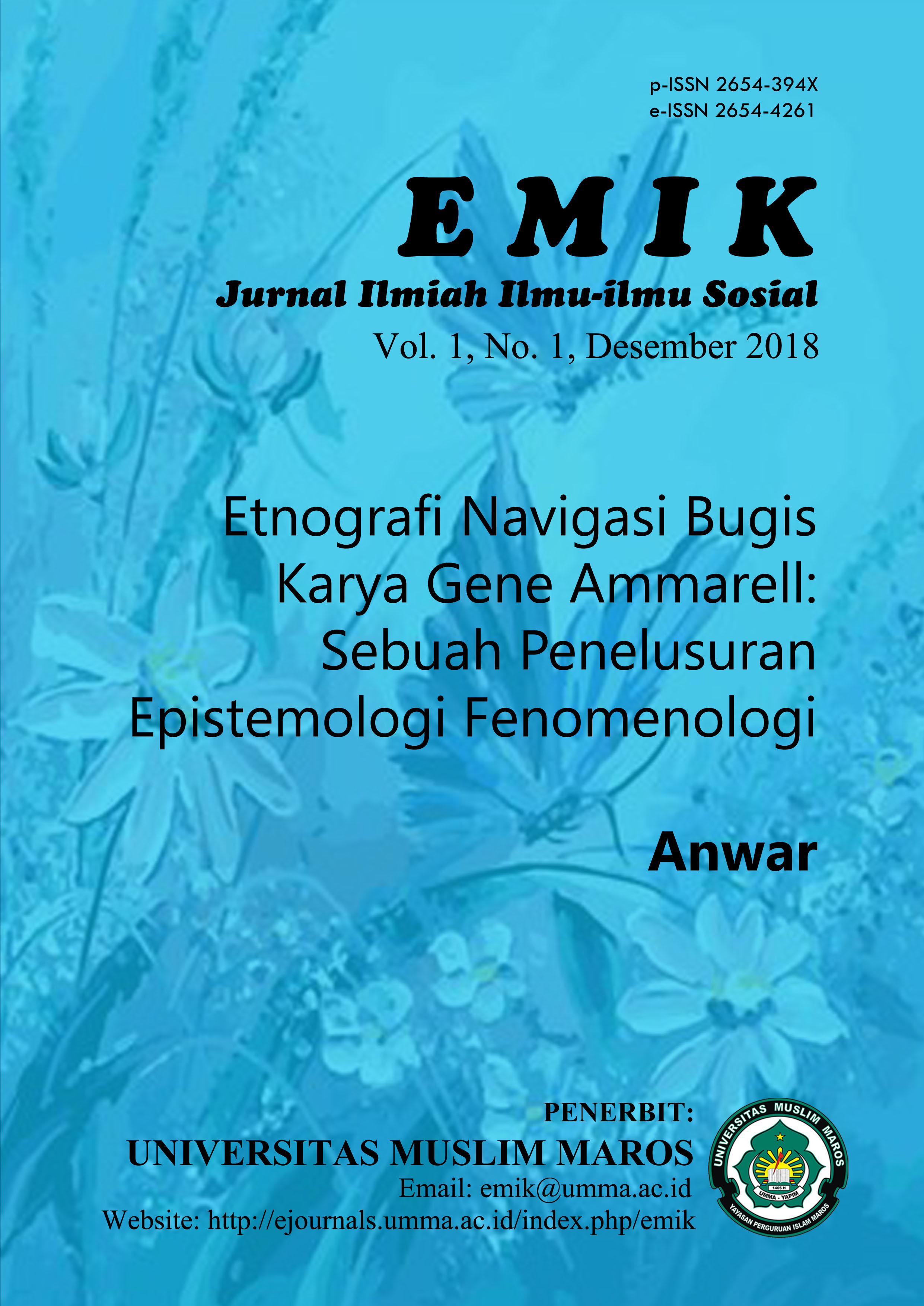Etnografi Navigasi Bugis Karya Gene Ammarell
Sebuah Penelusuran Epistemologi Fenomenologi
Keywords:
Epistemology, Phenomenology, Ethnoscience, Navigasi BugisAbstract
Nowdays, phenomenology as one of epistemologies in social science has contributed to the Anthropology. The phenomenological roots as a philosophy also enter and connected to the social science, especially in Anthropology. This journey was being started from Edmund Husserl to Alfred Schutz. Ethnoscience as part of the paradigms from phenomenology is a new identity in many Anthropological research. There are so many ethnographical researches which has using this perspective, but not many people who wants to focus and specific to explain the epistemology from that research. This article intends to fill that empty, in order to ethnographical research is not only we read and analyze as a practical reasons, but philosophical idea. This contribution has a big impact for Anthropology’s design in the future.
Methodological research from this article based on literature study not fieldwork as a usual (like observation and interview). Etnografi Navigasi Bugis by Gene Ammarell becomes an example to study about the epistemology from ethnographical research.
This ethnography is proven to be a phenomenological research and containing some assumptions that Bugis’ fisherman in Balabaloang has local knowledge about ocean navigation. What Gene Ammarell doing can attain a knowledge and consciousness (collective) about fisherman’s navigation in Balabaloang. Therefore, he also called as phenomenologist.
References
Abidin, Zainal. 2006. Filsafat Manusia: Memahami Manusia Melalui Filsafat. Bandung: PT Remaja Rosdakarya.
Adian, Donny Gahral. 2002. Pilar-Pilar Filsafat Kontemporer. Yogjakarta: Jalasutra.
Ahimsa-Putra, Heddy Shri. 1985. “Etnosains dan Etnometodologi: Sebuah Perbandingan”. Masyarakat Indonesia, XII(2):103-133.
_____________________. 1997b. “Antropologi Koentjaraningrat: Sebuah Tafsir Epistemologi” dalam E.K.M. Masinambow, Koentjaraningrat dan Antropologi di Indonesia. Jakarta: AAI dan Yayasan Obor Indonesia, 25-48.
_____________________. 2005. “Fenomenologi Gender di Jember sebuah kata pengantar dalam Hamdanah”, Lies Marcoes Natsir (ed.), Musim Kawin di Musim Kemarau: Studi atas Pandangan Ulama Perempuan Jember tentang Hakhak Reproduksi Perempuan. Yogyakarta: Bigraf.
_____________________. 2007. “Etnosains, Etnotek dan Etnoart: Paradigma Fenomenologis untuk Revitalisasi Kearifan Lokal” dalam Jumina dan Danang Parikesit (ed.), Kemajuan Terkini Riset Universitas Gadjah Mada. Yogyakarta: LPPM-UGM, 157-176.
_____________________. 2009. Paradigma Ilmu Sosial-Budaya: Sebuah Pandangan. Makalah disampaikan pada Kuliah Umum Paradigma Penelitian Ilmu-ilmu Humaniora diselenggarakan oleh Program Studi Linguistik, Sekolah Pascasarjana, Universitas Pendidikan Indonesia, di Bandung, 7 Desember 2009.
. 2011. “Wong Dulbur, Wong Legok dan Wong Tiban –Struktur Nirsadar Novel Jatisaba”. Makalah Bedah Buku. Yogyakarta: Universitas Gadjah Mada.
_____________________. 2012. “Fenomenologi Agama: Pendekatan Fenomenologi untuk Memahami Agama”. Walisongo, 20(2):271-304.
_____________________. 2016. Strukturalisme Levi-Strauss Mitos dan Karya Sastra. Yogyakarta: Kepel Press.
Ammarell, Gene. 2016. Navigasi Bugis. Makassar: Ininnawa.
Amundson, Ron. 1982.” Science, Ethnoscience, and Ethnocentrism”. Philosophy of Science, 49(2):236-250.
Idrus, Nurul Ilmi. 2016. Gender Relations in an Indonesia: Bugis Practices of Sexuality and Marriage. Leiden: Brill.
Marzali, Amri. 2016. “Menulis Kajian Literatur”. Jurnal Etnosia. 1(2):27-36.
Masinambow, E.K.M. 1997. Koentjaraningrat dan Antropologi di Idonesia. Jakarta: Yayasan Obor.
Moore, Henrietta, dan Sanders, Todd. 1979.” The Applicability of Kuhn’s Paradigms to the Social Sciences”. The American Sociologist, 14(1):28-31.
Murchison, Julian M. 2010. Ethnography Essentials: Designing, Conducting, and Presenting Your Research. USA: Jossey-Bass.
Nindito, Stefanus. 2005. “Fenomenologi Alfred Schutz: Studi Tentang Konstruksi Makna dan Realitas dalam Ilmu Sosial”. Jurnal Ilmu Komunikasi, 2(1):79-94.
Rahman, Alwi. 2016. Riview Buku: ‘Membaca’ dan ‘Dibaca’ Secara Polyglot: Gender, Seksualitas dan Perkawinan di Masyarakat Bugis. Jurnal Etnosia, 1(2):79-80.
Spradley, James P. 2007. Metode Etnografi. Yogyakarta: PT Tiara Wacana.
Suparlan, Parsudi. 1988. Prof. Koentjaraningrat: Bapak Antropologi Indonesia. Makalah untuk menyambut purna kedinasan Koentjaraningrat.
Werner, Oswald. 1969. “The Basic Assumptions of Ethnoscience”. Semiotica, 1(3):329-338.
_____________________. 1972. “Ethnoscience 1972”. Annual Review of Anthropology, 1:271-308.










9.png)















